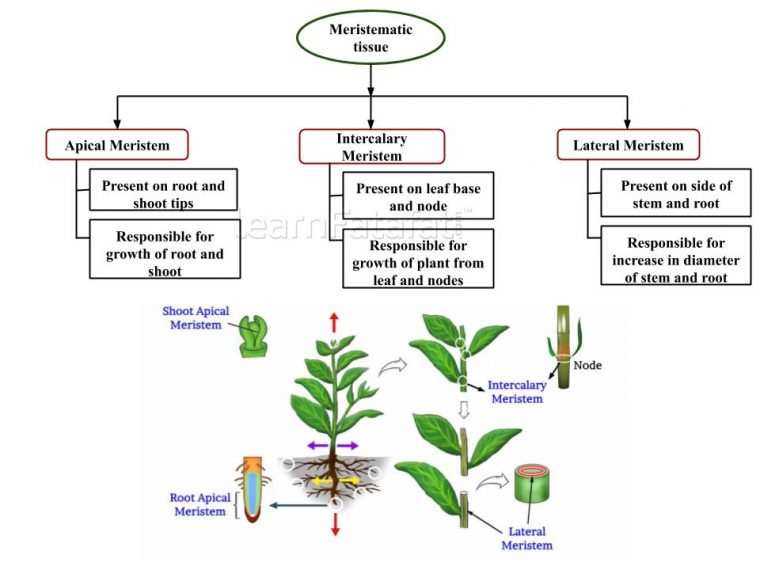- Tissues: Group of cell having similar structure performing particular function.
- Plant tissue- Meristematic tissue: This tissue have ability to divide and redivide themselves thereby, providing growth to plants. Classified into apical meristem, intercalary meristem and lateral meristem.

- Plant tissue – Simple Permanent Tissue: It is made up of same type of cells and is classified into parenchyma, collenchyma and sclerenchyma.
- Food storage and support
- Chlorenchyma prepares food during photosynthesis
- Aerenchyma have air in spaces which allow floating of plants in water
- Epidermis: It is outermost layer of plant that cover whole plant body.
- Single continuous layer of cell
- No intercellular spaces
- Cells are flattened
- Outer wall is thicker than inner wall
- Protection of plants from mechanical injury
- Absorption of water and nutrients from the soil through hair like structure
- Thick epidermis in desert plants prevents excess water loss
- Contains kidney shaped cell called stomata
- Allows the exchange of gases
- Enhance transpiration i.e. water loss from plant body
- Plant Tissue – Complex Permanent Tissue: Made of more than one type of cell.
- Complex permanent tissue is classified as xylem and phloem
- Xylem and phloem makes up vascular bundle, hence, are also known as vascular tissue
Xylem Phloem Type of cells - Tracheids
- Vessels
- Xylem parenchyma
- Xylem fibres
- Sieve tubes
- Companion cells
- Phloem parenchyma
- Phloem fibres
Dead / alive cell(s) Alive: Xylem parenchyma
Dead: Tracheids, Vessels, fibres
Alive: Sieve tubes, companion cells, phloem parenchyma
Dead: Phloem fibres
Structure and functions Tracheids and vessels: - Tube like structure
- Transports water and minerals in upward direction
Xylem Parenchyma:
- Storage of food
- Sideways conduction of water
Xylem fibres:
- Present between tracheids and vessels
- Provides mechanical support
Sieve tubes: - Tube like structure
- Walls of tubes contains holes
Phloem (Sieve tubes/ companion cells/ phloem parenchyma/ phloem fibres) :
- Transports food material to all parts of plant body
- Transportation is done in upward and downward direction
- Distinguish between Xylem and Phloem:
Xylem Phloem Tracheids, vessels and xylem fibres are dead cells. Phloem fibres are dead cells In vascular bundle, xylem occupies centre region In vascular bundle, phloem occupies outer region Transports water in upward direction, i.e. from roots to upper part of stem Transports food material in all direction Provides mechanical strength to plants Does not provide mechanical strength to plants - Animal Tissue – Epithelial Tissue:
- Cells are arranged in tile format
- Have no intercellular spaces
Epithelial Tissue Structure Location Function Squamous epithelium - Thin and flat
- Forms thin lining
- Number of layers of this tissue is called stratified squamous epithelium
Lining of mouth, oesophagus, blood vessels, lung alveoli, skin,etc. Transports material through selectively permeable membrane Columnar epithelium - Column like structure
- In respiratory tract contains cilia
Inner lining of intestine, stomach, respiratory tract etc - Absorption and secretion occurs
- Allows particles and mucus to move in right direction
Cuboidal epithelium - Cube like structure
- Undergo modification to form gland called glandular epithelium
Lining of kidney tubules, sweat glands, etc Secretion and absorption of material - Animal Tissue – Muscular Tissue: Allows movement of body due to presence of contractile proteins.
Muscle type Structure Location Function Striated muscle - Cells are cylindrical, elongated, unbranched, multinucleated
- Contain light dark band
Present in limbs Allows voluntary movements Smooth muscle - Cells are elongated, spindle shape, have single nucleus
- Does not contain striation
Present in alimentary canal, iris of eye, in ureter, in bronchi of lungs Allows involuntary movements Cardiac muscle - Elongated, cylindrical, branched, single nucleus
Heart Allows continuous contraction and relaxation - Animal Tissue – Connective Tissue:
Connective tissue Structure Function(s) Blood Contains Red Blood Corpuscles, White Blood Corpuscles and platelets - Provides essential nutrients and hormones
- Exchange gases and waste materials
Bone - Bone cells are fixed in hard matrix
- Hard matrix made up of calcium and phosphorous
- Forms body structure
- Site for production of white blood corpuscles
Ligament Strong, flexible with less matrix Connect two or more bones with each other Tendons Fibrous, strong, less flexible Connects bones with muscles Cartilage - Cells are fixed in matrix
- Matrix is made of sugar and protein
- Less rigid than bone
Provides supports Areolar Made up of fibroblast, collagen fibres, plasma, etc. - Binds skin with muscles
- Provides support to internal organs
Adipose Made up of fat cells - Stores energy
- Provides insulation to body
- Appears as protective covering around internal organ
- Animal Tissue – Nervous Tissue:
- Structure:
- Made up of nerve cells
- Axon :Long part of nerve cells
- Dendrites: Branched outgrowth along the nucleus
- Brain, spinal cord, nerves are made of nervous tissue
- Function(s): Passes signals to body parts in small time and helps to perform action instantly.
- Structure:
| Parenchyma | Collenchyma | Sclerenchyma | |
|---|---|---|---|
| Intercellular spaces | Large | Less | No spaces |
| Cell (Dead / Alive) | Alive | Alive | Dead |
| Cell wall | Thin | Irregularly thick | Thick |
| Functions |
|
Provides flexibility in plants | Provides rigidity and strength to plants |
| Structure of Epidermis | Functions of Epidermis |
|---|---|
|
|
|
|
|
|






